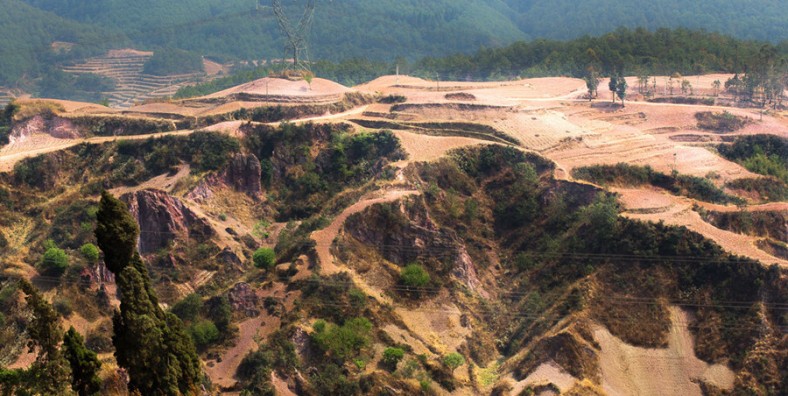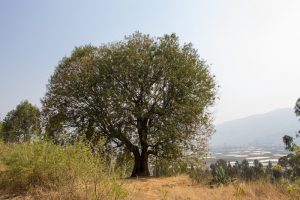
Liangwangshan Mountain in Kunming

Chinese Name: 昆明呈贡区梁王山
Chinese Pinyin: Kun Ming Cheng Gong Liang Wang Shan
English Name: Liangwangshan Mountain in Kunming
Type: Mountain, Natural Landmark
Recommended Visiting Time: Daytime
Address: Located between Chenggong District and Chengjiang County, over 40 kilometers away from Kunming
It is the heart of the cradle of the Ancient Dian Culture. In the Yuan Dynasty (1273-1368), the highest governor of Yunnan Liangwang (a Mongolian Prince) established the Liangwang Palace and trained soldiers on the mountain. Today, several historical sites of the drilling fields can be seen clearly. Highest altitude: 2,820 metres Duration: one day Route: Kunming-Qiumuqing (Chenggong District), or Kunming-Hengchong Reservoir (Chengjiang County)
Introduction
Liangwang Mountain is located between Chenggong District and Chengjiang County, over 40 kilometers away from Kunming. It is featured with characteristic karst landform. Ranging over hundreds of kilometers from south to north, the mountain boasts its magnificence and craggedness.
Grand views of four lakes and three rivers can be seen on the top of Liangwang Mountain. The four lakes are Dian Lake, Fuxian Lake, Xinyun Lake, Yangzonghai Lake, and the three rivers are Nanpan River, Panlong River, Tanglang River respectively.
Climate and Soil
Liangwangshan belongs to the monsoon climate area of the northern subtropical low latitude plateau, with mild climate, abundant illumination, obvious dry and wet, and the same season of rain and heat, which has the climatic characteristics of not synchronizing light and temperature. The annual mean temperature is 11.7 ℃, the maximum month (July) is 16.1 ℃, the lowest month (January) is 6.1 ℃, and the extreme minimum temperature is -3.9 ℃ -10.2 ℃. Annual rainfall of 1100-1400 mm, relative humidity 76 meters. Winter frost is more frequent, the average number of frost days in Liangwangshan is 92-144 days, the whole year is mostly south wind. The vertical distribution of most soil types is obvious, and the altitude is 1800. -2400 meters for red soil, purple soil alternate distribution zone, purple soil distribution is narrow, in the soil layer or thick, acidic.
The Resource of Liangwangshan Mountain
Because of the great difference in altitude and the vertical change of temperature, Liangwang Mountain is rich in resources.
Plant Resources

The total area of Liangwangshan is 34281 mu, including 28702 mu of forestry land, accounting for 83.7 mu, and 5578 mu of non-forestry land area, accounting for 16.3 mu. The forest land area was 20710 mu (72.1 mu); the shrub land was 2835 mu (9.9 mu); the unformed forest land was 5157 mu (17.9 mu). Liangwangshan has forest coverage of 60, shrub coverage of 8.3. The total volume of living trees is 55040 cubic meters. The main plant species are Pinus huashanensis, which are distributed in Pinus yunnanensis, Alnus cremastogyne, Cypress, Cunninghamia lanceolata, wild cherry and so on. Shrubs are mainly plants of Rhododendron family, with bamboo, wild privet, salt skin wood, Hypericum, water mahogany, Liang Wang tea, Myrica rubra, south candle, water mulberry, save gold grain and so on; Chinese herbal medicines have Pinellia ternata, Poria cocos, grass, heavy-green, gentian, wild Codonopsis, paeoniflorus and hundreds of other species.
Animal Resources
Protected areas include leopard cats, pangolin, foxes, pythons and other national secondary protected animals, Caragana, muntjac, owls, grass pigs, nine spirits, deer and other provincial secondary protection animals, as well as many other wild animals.
Major Scenic Spots
Liang Wangshan has the reputation of “the first famous mountain in central Yunnan, the king of mountain in Yunnan”, the reputation of “one mountain is divided into four seasons and 04:00 scenery is different”, is one of the ten scenery of Chengjiang River.
Recommended Travel Route
Kunming-Majinpu(马金铺, 30 kilometers, 45 minutes’ drive)-Fengkou Village(风口村, 3 kilometers, 45 minutes’ drive)-the mountain top(3 kilometers, 90 minutes by foot)

 7 Days GolfingTour
7 Days GolfingTour
 8 Days Group Tour
8 Days Group Tour
 8 Days Yunnan Tour
8 Days Yunnan Tour
 7 Days Shangri La Hiking
7 Days Shangri La Hiking
 11 Days Yunnan Tour
11 Days Yunnan Tour
 6 Days Yuanyang Terraces
6 Days Yuanyang Terraces
 11 Days Yunnan Tour
11 Days Yunnan Tour
 8 Days South Yunnan
8 Days South Yunnan
 7 Days Tea Tour
7 Days Tea Tour
 8 Days Muslim Tour
8 Days Muslim Tour
 12 Days Self-Driving
12 Days Self-Driving
 4 Days Haba Climbing
4 Days Haba Climbing
 Tiger Leaping Gorge
Tiger Leaping Gorge
 Stone Forest
Stone Forest
 Yunnan-Tibet
Yunnan-Tibet
 Hani Rice Terraces
Hani Rice Terraces
 Kunming
Kunming
 Lijiang
Lijiang
 Shangri-la
Shangri-la
 Dali
Dali
 XishuangBanna
XishuangBanna
 Honghe
Honghe
 Kunming
Kunming
 Lijiang
Lijiang
 Shangri-la
Shangri-la
 Yuanyang Rice Terraces
Yuanyang Rice Terraces
 Nujiang
Nujiang
 XishuangBanna
XishuangBanna
 Spring City Golf
Spring City Golf
 Snow Mountain Golf
Snow Mountain Golf
 Stone Mountain Golf
Stone Mountain Golf
















